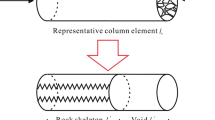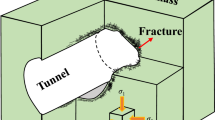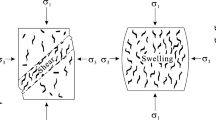Abstract
The study of constitutive model is of great significance to engineering safety evaluation and geological disaster prevention. In this paper, rock materials were regarded as a composite geological material composed of voids and rock matrix, and then a piecewise constitutive model bounded by the yield point was proposed. It can reflect the complete stress–strain curves of rocks, including the compaction stage, the elastic stage, the plastic yield stage and the post-peak stage. Primarily, an objective method to determine the yield point based on the stress difference was proposed. For the rock deformation before yielding, the relationship between the strain of rock materials and the strains of voids and rock matrix was analyzed to establish the corresponding constitutive model. Subsequently, based on the modified Weibull distribution, a damage statistical constitutive model of rocks was established to describe the nonlinear deformation after the yield point. Meanwhile, the determining method of model parameters was given. Finally, the uniaxial and triaxial compression test data of different types of rocks were used to verify the proposed model. The results indicate that the model curves are in good agreement with the experimental results. Hence, it is feasible and reasonable to divide the macroscopic strain of rocks into the strains of voids and rock matrix. Additionally, there is a power function attenuation relationship between the deformation ratio of voids to rock matrix and the axial stress.

















Similar content being viewed by others
References
Xie H, Zhu J, Zhou T, Zhang K, Zhou C. Conceptualization and preliminary study of engineering disturbed rock dynamics. Geomech Geophys Geol. 2020;6(2):34. https://doi.org/10.1007/s40948-020-00157-x.
Zhou JK, Chen XD. Stress-strain behavior and statistical continuous damage model of cement mortar under high strain rates. J Mater Civil Eng. 2013;25(1):120–30. https://doi.org/10.1061/(ASCE)MT.1943-5533.0000570.
Cook N. The failure of rock. Int J Rock Mech Min Sci. 1965;2(4):389–403. https://doi.org/10.1016/0148-9062(65)90004-5.
Han Z, Li D, Zhou T, Zhu Q, Ranjith PG. Experimental study of stress wave propagation and energy characteristics across rock specimens containing cemented mortar joint with various thicknesses. Int J Rock Mech Min Sci. 2020;131: 104352. https://doi.org/10.1016/j.ijrmms.2020.104352.
Zhou WY, Yan GR, Yang RQ. Elasto-brittle damage model for rockmass based on field tests in Laxiwa arch dam site. Chin J Geotech Eng. 1998;05:57–60.
Toshikazu K. An analysis of excavation in strain-softening rock mass. Proc Jpn Soc Civ Eng 1981:107–18.
Zhang JM, Liu YH, Luo CH, Shen SR. Triaxial compression test and constitutive model for red mudstone of badong formation. J Eng Geol (in Chinese). 2013;21(01):138–42.
Feng WL, Qiao CS, Wang T, Yu MY, Niu SJ, Jia ZQ. Strain-softening composite damage model of rock under thermal environment. B Eng Geol Environ. 2020;79(8):4321–33. https://doi.org/10.1007/s10064-020-01808-9.
Duncan JM, Chang C-Y. Nonlinear analysis of stress and strain in soils. J Soil Mech Found Div. 1970;96(5):1629–53. https://doi.org/10.1061/JSFEAQ.0001458.
Mazars J, Pijaudier-Cabot G. Continuum damage theory—application to concrete. J Eng Mech. 1989;115(2):345–65.
Løland KE. Continuous damage model for load-response estimation of concrete. Cement Concrete Res. 1980;10(3):395–402.
Chen Y, Lin H, Wang Y, Xie S, Zhao Y, Yong W. Statistical damage constitutive model based on the Hoek-Brown criterion. Arch Civ Mech Eng. 2021;21(3):117. https://doi.org/10.1007/s43452-021-00270-y.
Cao K, Ma L, Wu Y, Spearing A, Khan N, Xie Y. The determination of a damage model for mudstone under uniaxial loading in acidic conditions. Geofluids. 2020;2020:1–12. https://doi.org/10.1155/2020/8888750.
Liu HH, Rutqvist J, Berryman JG. On the relationship between stress and elastic strain for porous and fractured rock. Int J Rock Mech Min Sci. 2009;46(2):289–96. https://doi.org/10.1016/j.ijrmms.2008.04.005.
Cao WG, Zhao H, Li X, Zhang YJ. Statistical damage model with strain softening and hardening for rocks under the influence of voids and volume changes. Can Geotech J. 2010;47(8):857–71. https://doi.org/10.1139/t09-148.
Lemaitre J. A continuous damage mechanics model for ductile fracture. J Eng Mater. 1985. https://doi.org/10.1115/1.3225775.
Cao WG, Zhang C, He M. Voids change and statistical damage simulation method of the full deformation process for rocks. J Hunan Univ. 2017;44(9):100–6. https://doi.org/10.16339/j.cnki.hdxbzkb.2017.09.012.
Zhang C, Cao WG, Xu Z, He M. Initial macro-deformation simulation and determination method of micro-crack closure stress for rock. Rock Soil Mech. 2018;39(4):1281–8. https://doi.org/10.16285/j.rsm.2016.0863.
Peng J, Rong G, Zhou CB, Peng K. A study of crack closure effect of rocks and its quantitative model. Rock Soil Mech. 2016;37(1):126–32. https://doi.org/10.16285/j.rsm.2016.01.015.
Peng J, Rong G, Cai M, Zhou CB. A model for characterizing crack closure effect of rocks. Eng Geol. 2015;189:48–57. https://doi.org/10.1016/j.enggeo.2015.02.004.
Lin Y, Zhou K, Gao F, Li J. Damage evolution behavior and constitutive model of sandstone subjected to chemical corrosion. B Eng Geol Environ. 2019;78(8):5991–6002. https://doi.org/10.1007/s10064-019-01500-7.
Corkum AG, Martin CD. The mechanical behaviour of weak mudstone (Opalinus Clay) at low stresses. Int J Rock Mech Min Sci. 2007;44(2):196–209. https://doi.org/10.1016/j.ijrmms.2006.06.004.
Zhao LY, Shao JF, Zhu QZ, Liu ZB, Yurtdas I. Homogenization of rock-like materials with plastic matrix based on an incremental variational principle. Int J Plasticity. 2019;123:145–64. https://doi.org/10.1016/j.ijplas.2019.07.015.
Timoshenko SP, Goodier JN. Theory of elasticity. 1970.
Li X, Cao WG, Su YH. A statistical damage constitutive model for softening behavior of rocks. Eng Geol. 2012;143:1–17. https://doi.org/10.1016/j.enggeo.2012.05.005.
Zhang HM, Yuan C, Yang GS. A novel constitutive modelling approach measured under simulated freeze-thaw cycles for the rock failure. Eng Comput. 2021;37(1):779–92. https://doi.org/10.1007/s00366-019-00856-4.
Deng J, Gu DS. On a statistical damage constitutive model for rock materials. Comput Geosci. 2011;37(2):122–8. https://doi.org/10.1016/j.cageo.2010.05.018.
Chen S, Qiao CS, Ye Q, Khan MU. Comparative study on three-dimensional statistical damage constitutive modified model of rock based on power function and Weibull distribution. Environ Earth Sci. 2018;77(3):108. https://doi.org/10.1007/s12665-018-7297-6.
Wang JB, Song ZP, Zhao BY, Liu XR, Liu J, Lai JX. A study on the mechanical behavior and statistical damage constitutive model of sandstone. Arab J Sci Eng. 2018;43(10):5179–92. https://doi.org/10.1007/s13369-017-3016-y.
Xie SJ. Nonlinear shear constitutive model for peak shear-type joints based on improved Harris damage function. Arch Civ Mech Eng. 2020. https://doi.org/10.1007/s43452-020-00097-z.
Lyu Q, Tan JQ, Dick JM, Liu Q, Gamage RP, Li L, et al. Stress-Strain modeling and brittleness variations of Low-Clay Shales with CO2/CO2-water imbibition. Rock Mech Rock Eng. 2019;52(7):2039–52. https://doi.org/10.1007/s00603-018-1687-7.
Lin H, Feng JJ, Cao RH, Xie SJ. Comparative analysis of rock damage models based on different distribution functions. Geotech Geol Eng. 2021. https://doi.org/10.1007/s10706-021-01899-5.
Bai Y, Shan RL, Ju Y, Wu YX, Sun PF, Wang ZE. Study on the mechanical properties and damage constitutive model of frozen weakly cemented red sandstone. Cold Reg Sci Technol. 2020;171: 102980. https://doi.org/10.1016/j.coldregions.2019.102980.
Li XL, Chen HK, Zhang JH. A statistical damage model for rock full deformation process with considering the characteristics of initial void compaction. J Southwest Jiaotong Univ (in Chinese). 2020;55:1–8.
Olalla C, Martin M, Sáez J. ED-B experiment: geotechnical laboratory test on Opalinus Clay rock samples: Technical report TN98–57, Mont Terri Project 1999.
Xie SJ, Lin H, Chen YF, Wang YX. A new nonlinear empirical strength criterion for rocks under conventional triaxial compression. J Cent South Univ. 2021;28(5):1448–58. https://doi.org/10.1007/s11771-021-4708-8.
Acknowledgments
The present research is financially supported by the National Natural Science Foundation of China (No. 51774322), Hunan Provincial Key Research and Development Program (2022SK2082), Hunan Provincial Natural Science Foundation of China (2018JJ2500), and Postgraduate Research & Practice Innovation Program of Jiangsu Province (No. KYCX21_0119).
Author information
Authors and Affiliations
Corresponding authors
Ethics declarations
Conflict of interest
The authors declare no conflicts of interest.
Additional information
Publisher's Note
Springer Nature remains neutral with regard to jurisdictional claims in published maps and institutional affiliations.
Rights and permissions
About this article
Cite this article
Xie, S., Han, Z., Chen, Y. et al. Constitutive modeling of rock materials considering the void compaction characteristics. Archiv.Civ.Mech.Eng 22, 60 (2022). https://doi.org/10.1007/s43452-022-00378-9
Received:
Revised:
Accepted:
Published:
DOI: https://doi.org/10.1007/s43452-022-00378-9




